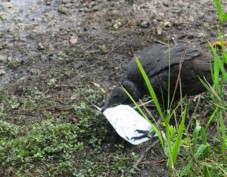William E. Davis, Jr.
In a previous “Field Note” I reported on observations of two subadult Black Vultures (Coragyps atratus) making daredevil rushes to the snout of an alligator to grab a stick and retreat. I suggested it was practice foraging behavior and thus an example of play (Davis 2013). On March 7, 2015, at about 10:15 am, I was again on Anhinga Trail in Everglades National Park in South Florida, and at the same spot where I made my previous observations. I watched Black Vultures play with a laminated fish identification sheet that had presumably been dropped onto the mud below the boardwalk rail. Initially, a single subadult bird approached the card and played with it. In the following minutes three other subadult vultures joined in, with up to three birds involved at one time (Figure 1). Finally, two adults joined the fun and played with the card. Hence at least 6 of the 14 congregated vultures were involved in playing with the card. During approximately 15 minutes of observation, the card had been moved six feet. I returned 45 minutes later to find the card had been moved an additional eight feet, presumably by the playing vultures.
The play included standing on the card and pecking at it (Figure 2), putting the beak under the card and raising it (Figure 3), standing on the card and bending it up with the beak by grasping the card’s edge (Figure 4), sometimes until the card was vertical (Figure 5), and picking the card up by its edge and tossing it (Figure 6).
In young birds, play often mimics adult behavior, such as fighting or foraging, and occurs in a broad spectrum of birds (Fagen 1981). Further, it has been suggested that such play is a way of developing and practicing skills necessary for adult survival (Kilham 1974). So, what skills are being developed or practiced by the play behavior of the vultures in this instance? The fact that two adults joined in the card playing casts some doubt on the idea that the play was strictly for skill development. But the play does resemble the feeding methods used by Black Vultures: pecking at small scraps on the ground or on the carcass, pulling out pieces of muscle or viscera, and tearing off pieces of tendon and skin (Buckley 1999). While observing the vultures playing with the card, I also saw one bird pull at grass roots and another pick up a stick and toss it in the air. Hence some sort of play behavior may be common in Black Vultures, and although probably rooted in skill development, there may be an aspect of something analogous to pleasure in their play.

Fig. 1. Black Vultures and laminated fish identification sheet. (All photographs by the author).

Fig. 2. Black Vulture standing on card and pecking at it.

Fig. 3. Black Vulture putting beak under the card and raising it.

Fig. 4. Black Vulture standing on the card and bending it.

Fig. 5. Black Vulture bending the card vertically.

Fig. 6. Black Vulture picking up card by its edge and tossing it.
Literature Cited
- Buckley, N. J. 1999. Black Vulture (Coragyps atratus). In The Birds of North America, No. 411 (A. Poole and F. Gill, eds.). Philadelphia: The Birds of North America, Inc.
- Davis, We. E., Jr. 2013. Play Behavior by Black Vultures? Bird Observer 41: 290–92.
- Fagen, R. 1981. Animal Play Behavior. New York: Oxford University Press.
- Kilham, L. 1974. Play in Hairy, Downy, and Other Woodpeckers. Wilson Bulletin 86: 35-42.
Ted Davis thanks John Kricher for reading an earlier draft of the manuscript.